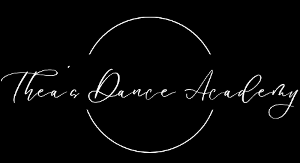November 12, 2021/By theadance/0/Dance, Flexibility, Health and Harmony
Try these stretches to achieve square splits
November 11, 2021/By theadance/0/Dance, Flexibility, Health and Harmony
3 TIPS TO HELP WITH LEG HOLD TURNS
Try these 3 exercises to perfect your leg holds turns!
November 12, 2019/By theadance/0/Dance, Flexibility, Health and Harmony
BALANCE & STRENGTH WORKING THROUGH PARALLEL | TECHNIQUE TUESDAY TIP
As dancers, we tend to work our turnout 90% of the time which causes us to lose strength, flexibility, and stability when working in a parallel position. Try this exercise to help gain that strength and work on your balance while remaining in a parallel position with square hips.
Start by standing with your left foot centered on the half-disc and your right leg in parallel passé. Slowly extend your right leg in front of you then return to passé and extend into arabesque while keeping hips as square as possible. Repeat for 10 reps before trying this on your other side.
October 22, 2019/By theadance/0/Dance, Flexibility, Health and Harmony
HIP EXTENSION | GLUTE STRENGTH | TECHNIQUE TUESDAY TIP
Try this exercise to help strengthen your glutes while stretching out the hip flexors so that you can achieve your greatest ROM in hip extension. Start by laying on your stomach in the sphinx position, keeping your chest lifted and spine long. Then kick your left leg into arabesque. Only kick as high as you can while keeping your hips on the ground and legs straight. Kick 10x with a straight leg then kick 10x with attitude. When performing attitude kicks, make sure you are getting your knee as high off of the ground as possible before bending in the knee. Repeat on your other leg with 10 arabesque kicks and 10 attitude kicks.
September 24, 2019/By theadance/0/Dance, Flexibility, Health and Harmony
KNEE EXTENSION | BACK OF KNEE FLEXIBILITY & QUAD STRENGTH | TECHNIQUE TUESDAY
Do you have trouble fully straightening your legs when performing your leaps, leg extensions, and other dance skills? Or do you find that even when your legs are fully extended you still don’t have the flexibility to get that nice straight line through the back of your leg? If so, today’s #techniquetuesdaytip can help! There are many reasons why you may be having trouble in this area, but 2 common reasons are; lack of strength in the quadriceps(prime movers in knee extension) and lack of flexibility through the back of the legs. Specifically near the knee joint.
I will go over the exercises/stretches that are featured in this video but please keep in mind that you should not be hyperextending or locking out in your weight-bearing knee.
-
Start by sitting in a straddle position with your arms in 2nd position and spine long and lengthened. Slowly alternate between flex and point through your feet. Be sure to engage your quads so that the backs of your knees are pushing into the floor and heels begin to lift off of the floor. You may not be able to get your heels off just yet and that’s okay! Repeat for 10-15 reps.
-
Staying in this position with feet flexed. Reach and grab the ball of your R foot and pull towards you. Then repeat with your left foot.
-
Starting in a seated pike position with feet pointed, engage your quads and think of driving the backs of your knees into the floor and lifting the heels off of the floor. Then relax and repeat for 15 reps.
-
Staying in the piked position with feet flexed. Slowly reach towards your feet with a straight spine and grab the balls of your feet and pull towards you. Lifting the heels higher off of the floor. Hold for 10-20 seconds at a time.
September 3, 2019/By theadance/0/Dance, Flexibility, Health and Harmony, Strength Training
STRAIGHT HANDSTAND ALIGNMENT & STRENGTH | TECHNIQUE TUESDAY TIP!
Using a wall to practice your handstands is a great asset but can also create bad habits if not performed correctly. Today’s tip will help you with getting into your straight handstand as well as learning to keep your balance without the wall.
Start by placing your fingertips 1-2 inches away from the wall with hands no wider than shoulder-width apart. Kick into your handstand with your vision on the opposing wall. (if performing a straight handstand, for curved handstand your eyes will stay on your fingers) You may bend the leading leg as pictured here to help you land lightly on the wall and find control. Once in handstand, you will straighten your legs and lengthen through your spine as you think of pushing the floor away from you and knitting your ribs together like a corset. Think of drawing in and up through your core! If your hips remain close to the wall then you are more than likely arching in your back so try to pull those hips into a posterior hip tilt, straightening and lengthening through the spine as you slowly take one foot off of the wall at a time to find your balance. If you are unable to balance without feet leaving the wall, you may maintain this posture and hold. Try holding for 20-30 seconds before coming down one foot at a time. The longer you hold, the more strength you will build:)
#techniquetuesday
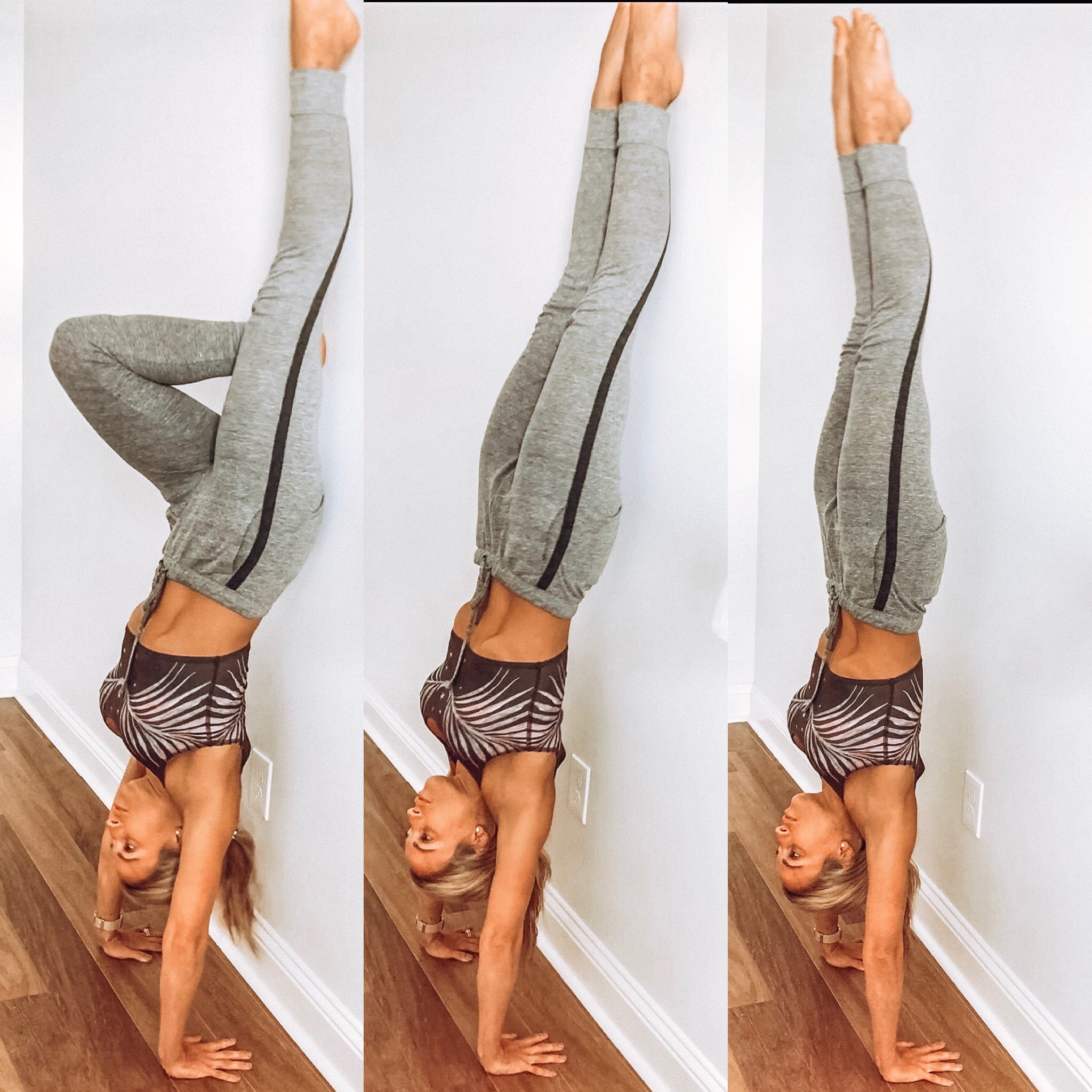
August 27, 2019/By theadance/0/Dance, Flexibility, Health and Harmony
TURNOUT IN A LA SECONDE TURNS | TECHNIQUE TUESDAY TIP
Having trouble with keeping your working leg turned out when performing A La Seconde turns? Do you tend to lift your hip and internally rotate your femur until reaching 2nd position? Try this exercise to strengthen the muscles needed to lift and rotate the femur as you move in and out of 2nd position. Start by placing 2-3 blocks about 6 inches apart on a raised surface(slightly lower than hip level) with the back block in line with your natural turnout. Lift your working leg over the first block and slowly lower between the next block, repeat once more then reverse this action until you are back where you started. Repeat this exercise 10x before switching legs. Even if you don’t have these turns on your opposite leg, be sure to do both sides so that you’re keeping your muscles in balance:) #techniquetuesdaytip #techniquematters
August 20, 2019/By theadance/0/Dance, Flexibility, Health and Harmony
TURNOUT & EXTERNAL HIP ROTATION | TECHNIQUE TUESDAY TIPS WITH ZANDER
My pup just had to be a part of the mix for today’s video and he’s too adorable to leave out so here it is Today’s #techniquetuesday tip focuses on the muscles used in external rotation of the hip aka femur external rotation. Which is very important for dancers to properly perform the many skills requiring turnout. Start by sitting on the floor with your legs in a piked position and a long and lifted spine.(you can sit with your back against the wall for support if needed) Lift one leg off of the floor while remaining parallel then slowly rotate your leg until your knee is facing away from center line then return to parallel. Make sure that the rotation is coming from the hip joint and that you are keeping your leg center during this rotation. Repeat 10-20x each leg.
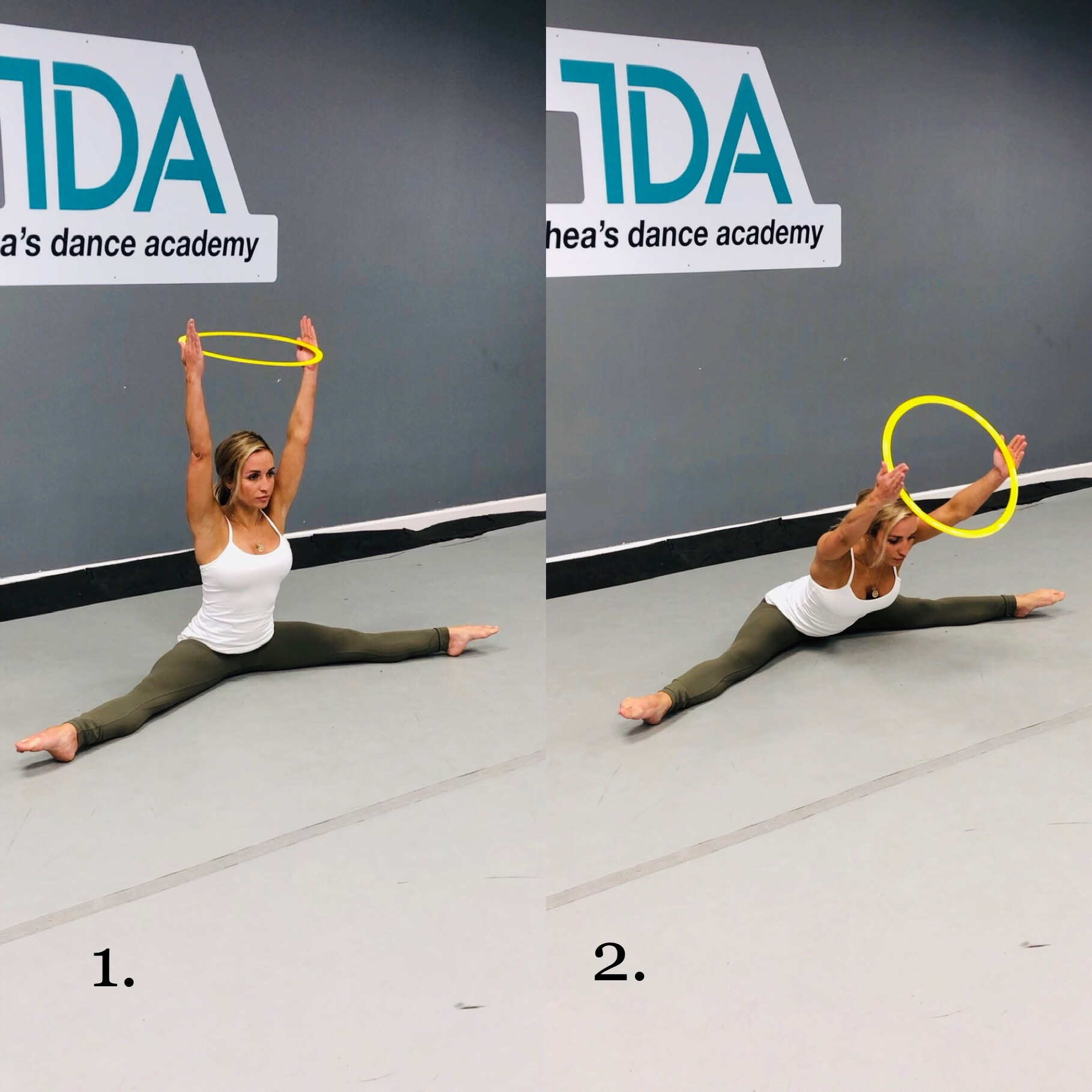
June 18, 2019/By theadance/0/Flexibility, Health and Harmony
LOWER BACK STRENGTH & SPINAL STABILIZATION IN STRADDLE | TECHNIQUE TUESDAY TIP
Do you or your dancers ever have trouble with rounding in your lower back rather than keeping the spine long and lengthened when in straddle? Or do you find yourself bending in the knees or rotating then inwards to compensate? Today’s exercise is focused on building the strength and stabilization throughout your spine and hips to help with just that while also giving those legs a good stretch.
Starting in a seated straddle position on the floor with knees pointing up. Place a ring between both hands with your arms fully extended over your head. Making sure that your arms remain next to your ears the entire time, slowly lower your upper body towards the floor as far as you can go without losing control or form. Then return to starting position. If your knees bend or arms drop then you have gone too far. Try this exercise for 3 sets of 10 reps.
Quick tip: If you have a really wide straddle, try narrowing your legs at first until you have built up the strength to perform in full straddle.
May 14, 2019/By theadance/0/Flexibility, Health and Harmony
BEGINNER SCORPION STRETCH | TECHNIQUE TUESDAY TIP
Scorpion pose has become increasingly popular in the dance world and many dancers are lacking the flexibility to perform this skill safely and correctly. Today’s tip is a simple stretch that will help you to gain the flexibility needed in your Upper, Mid, and Lower back as well as your hips and shoulders. Most dancers assume that back flexibility is the only thing needed to perform a straight scorpion. Which causes them to put all of the strain on their lower backs and making them more prone to injury.
The stretch featured in today’s post is great for beginners or those with limited range of motion and will help you move closer towards your goal.
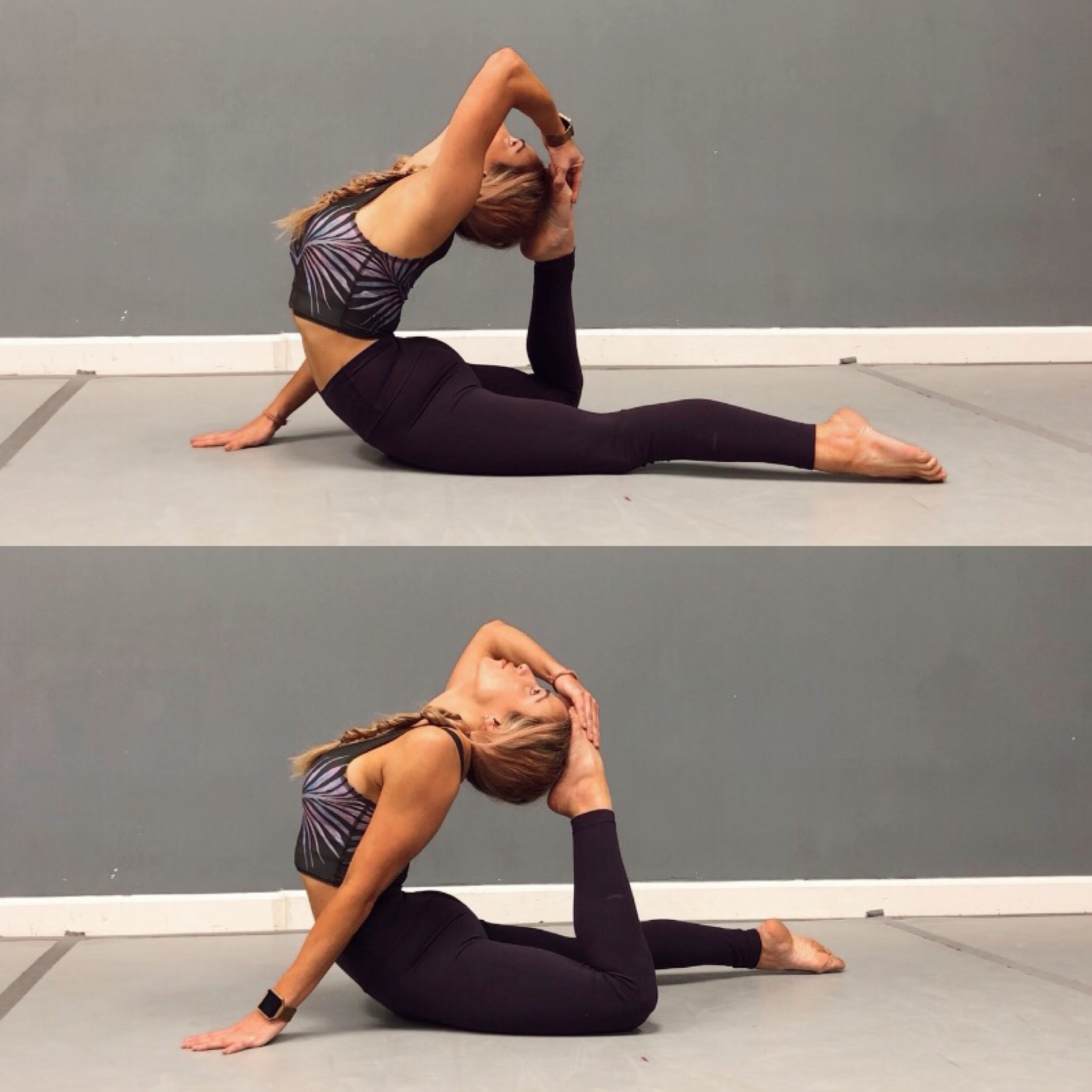
Start in a cobra position with hips pressing towards the floor, spine lengthened, and legs engaged. Slowly lift your right arm and bend your left knee until the foot is touching your forehead and you can grab the foot. Then repeat on the other side. If you are not ready to lift your arm off of the floor you can also perform this exercise without the grab and just work on bringing the feet to your head.
May 7, 2019/By theadance/0/Flexibility, Health and Harmony
BACK FLEXIBILITY & STRENGTH | TECHNIQUE TUESDAY TIP
Flexibility and Strength of your back, hips, and chest muscles are crucial for dancers! Especially when performing the advanced skills you see these days.
Todays Technique Tuesday tip is an exercise to help work on the flexibility of the back, chest and hips muscles while building the strength in the spine and other stabilizers to support this flexibility.
Start on your knees(hip-width apart) and arms overhead with hand together. Try to keep your arms behind your ears for the duration of this exercise. Slowly press your hips forward as you lengthen up and back for a backbend. Keep arching back as far as you can without compromising form then return to your starting position, leading with the hips than one vertebra at a time. Repeat this exercise 10-20 times.
April 23, 2019/By theadance/0/Flexibility, Health and Harmony
STRETCHING YOUR OVERSPLITS | TECHNIQUE TUESDAY TIP
If you can easily perform an oversplit and are looking for a way to challenge your front split stretch during class without the use of equipment. Then today’s tip is for you!
Starting in a front split stretch, lower your upper body towards your front leg until forearms are flat on the ground. Grab your ankle with your hands and lift the front leg off of the ground and hold for a few seconds before lowering and then repeating.
April 16, 2019/By theadance/0/Flexibility, Health and Harmony, Strength Training
CORE STRENGTH FOR DANCERS WITH FLEXIBLE LOWER BACKS |TECHNIQUE TUESDAY TIP
Many dancers and gymnast have incredible flexibility in their Lumbar Spine, which can be a great asset. However, this can cause instability in the spine and lead to long term injuries if dancers do not strengthen the core and learn how to lengthen the spine without arching. Here, we are going to work on lengthening without arching and learn to engage the appropriate muscles while doing so.
Starting in a quadruped position with a foam roller(or other object) on the lower back. Draw in your core and think of pressing your lower back into the foam roller. Slowly extend your right arm and left leg until they are in line with your body. Doing this without arching the back. Then return to the same position and repeat with opposite arm and leg. Repeat this for 3 set of 20 reps.
April 9, 2019/By theadance/0/Flexibility, Health and Harmony
LEG EXTENSION EXERCISES | TECHNIQUE TUESDAY TIP
Today’s tip is targeted towards strengthening the quadriceps as well as the psoas and other prime mover muscles that are involved in performing a leg extension. Your quads are the prime mover in knee extension. Meaning they are responsible for straightening your leg. The psoas and a few other hip flexors are the prime movers in hip flexion. Which is what happens when we lift our leg in front of us for battements and various leaps. Strengthing these muscles will allow for greater control and strength in your leg extensions, leaps, battements and everything in between.
Seated knee extension w/ ankle weights- Find a seated position on a bench or set of mats with ankle weights on. Start with your feet touching the floor and slowly straighten the knee until feet are in line with the thigh bone. Return to the starting point and repeat 20x.
Seated leg lifts– Starting in the same seated position but with legs fully extended, slowly raise one leg as high as you can without altering form. Slowly lower and raise the other leg. Never bend at the knees. Perform this exercise 10x on each side.
Seated knee extension to leg lift- Now we will just combine the above 2 exercises into one. Starting with your feet on the floor slowly straight both legs until parallel then raise your right leg into a leg lift while the left remains straight. Lower both legs to starting point and then repeat but with the left leg. Perform this 20x
April 2, 2019/By theadance/0/Flexibility, Health and Harmony
HIP STRENGTH | TURNOUT | TECHNIQUE TUESDAY TIPS
Developing hip strength and turnout is very important for dancers! Especially when it comes to safely and effectively performing the amazing skills we do in routines. Try this exercise to help strengthen all those muscles responsible for laterally abducting and externally rotating your leg.
Lay flat on your side with legs extended and a circle resistance band around your thighs. Slowly raise your top leg towards the ceiling and then externally rotate to your natural turn out. With control, reverse this combo and return to starting position and repeat for 20 reps before performing this exercise on the other side.
March 19, 2019/By theadance/0/Flexibility, Health and Harmony
BALANCE AND CONTROL | TECHNIQUE TUESDAY TIP
Balance and Control are incredibly important for dancers! Not only in regards to safety but also in regards to maneuvering through routines seamlessly. Try this exercise to help test your balance and control.
Start standing on a half-disc with your foot centered. Slowly raise the working leg into an arabesque position with arms in 2nd. Next, bring your working leg into a turned out retire position and arms into 1st then slowly extend your leg out to the front. Slowly reverse this combo and then repeat. Make sure you complete this exercise on both sides:)
March 12, 2019/By theadance/0/Dance, Flexibility, Health and Harmony
CORE STRENGTH | LOWER BACK & HIP STABILIZATION | TECHNIQUE TUESDAY TIP
Core Strength | Hip and Lower Back Stabilization
It’s no surprise that having a strong core is important in dance but many of us forget about hip and lower back stabilization. Which is crucial when it comes to protecting our dancers bodies when moving through different planes of motion.
To help with this issue, try this exercise using a foam roller. Lay back on the roller, centering your body and places hands wide to the side for support. The less you use your hands the better. Lift knees to table top position at hip level while pressing your lower back into the foam roller. Slowly extend one leg while bringing the other into retiré. Continue to alternate sides while maintaining the position of the core.
March 5, 2019/By theadance/0/Flexibility, Health and Harmony
PIROUETTES | TECHNIQUE TUESDAY TIP
Proper technique in pirouettes is crucial to getting the maximum rotations every time. Try this exercise to help!
->With one hand’s support on the bar, start in retire position with your right leg.
->Holding this position, Lift up through relevé in your supporting foot.
->As you gain control of your balance, slowly release the bar while maintaining proper form. Try to balance here in retire on relevé for as long as possible.
**If you start to lose your balance, use the bar for support and try again! With time and practice, you’ll be able to hold that relevé for maximum rotations in your pirouettes!**
February 15, 2019/By theadance/0/Flexibility, Health and Harmony
STRETCH YOUR WAY TO A STRAIGHT SCORPION POSE!
Would you like to perfect your Scorpion pose but aren’t sure how? We are here to help. In this post, I will go over a few stretches that help open your shoulders and back to allow a greater range of motion in your scorpion pose.
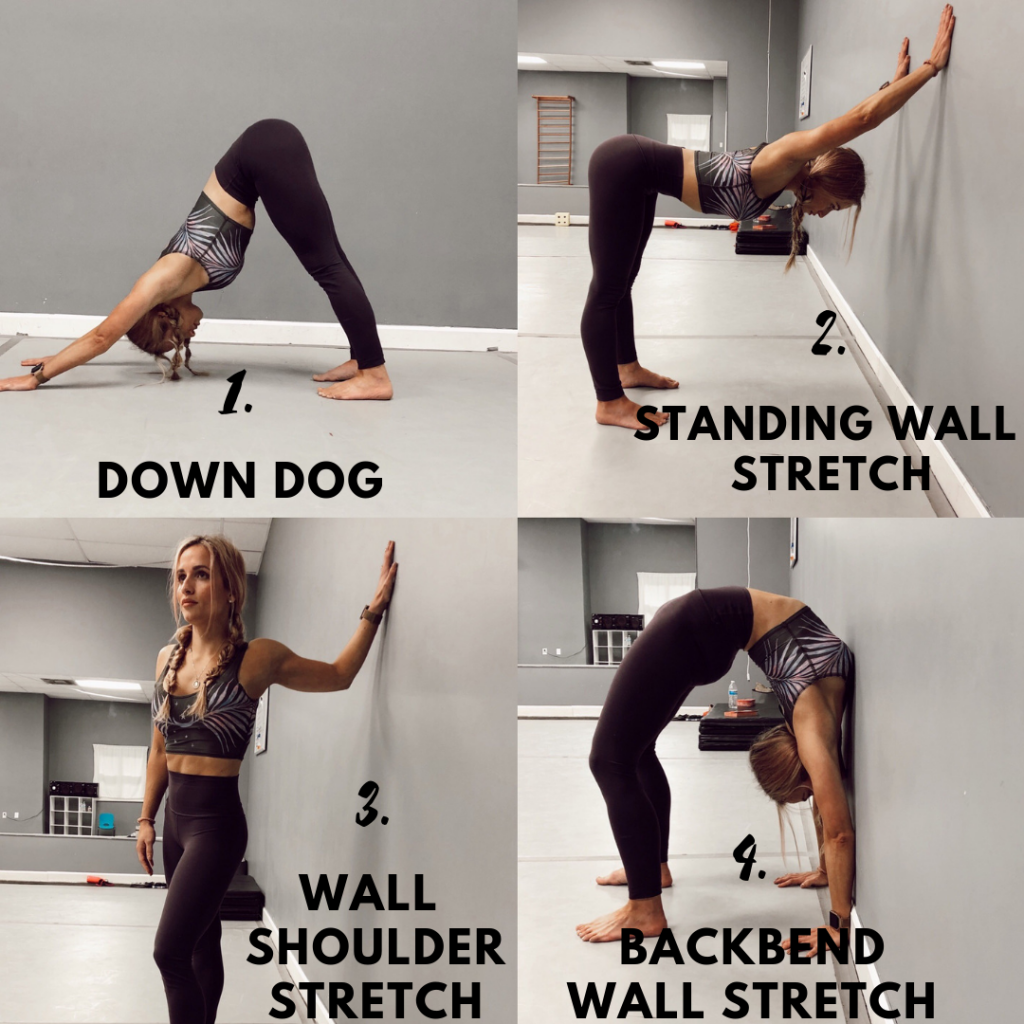
First things first, lets get those shoulders open. Most people don’t realize it but shoulder flexibility is a huge part of getting a great scorpion. Try these 4 stretches to really open up the different muscles in your upper body and shoulders.
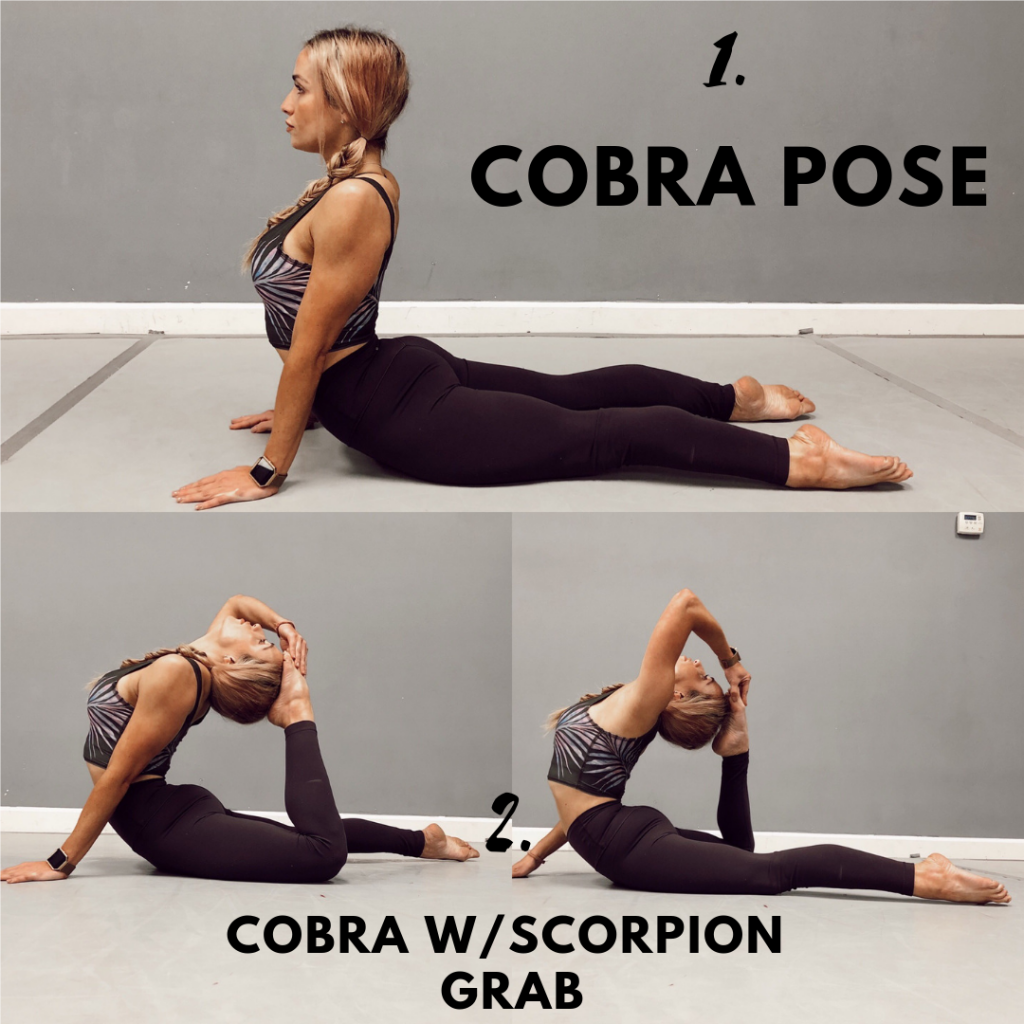
Next, we will start to warm up the back and hip flexors by starting in a basic cobra pose. Pressing your hips towards the floor as you lengthen through your spine. Once you have achieved this pose, slowly bend one knee bringing your foot to your head and grabbing the foot with the opposite hand. Then repeat on the other side.
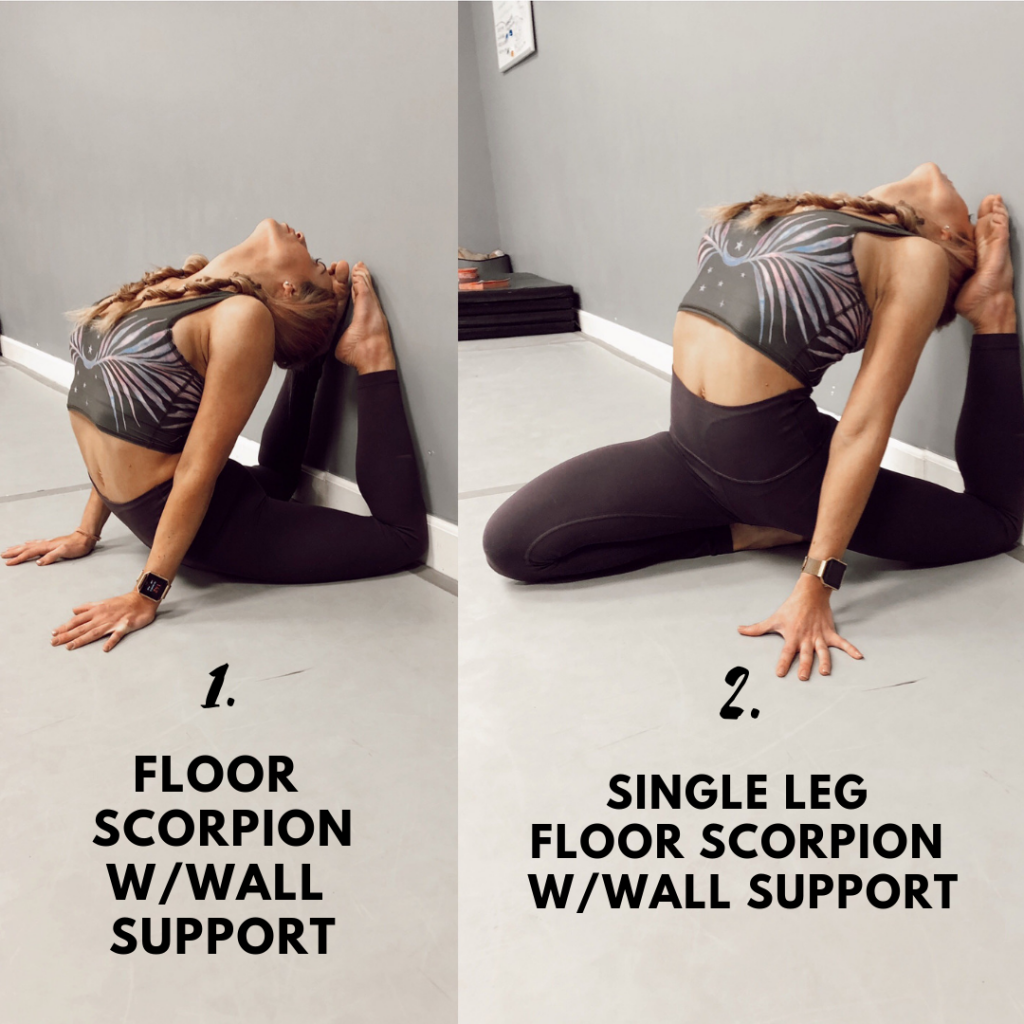
Now we are going advance to the floor scorpion with wall support. This is a great skill to practice to if you have a hard time grabbing the foot or keeping hips aligned. In both of these skills, your focus is to keep pressing your hips forward as you lengthen and arch back.
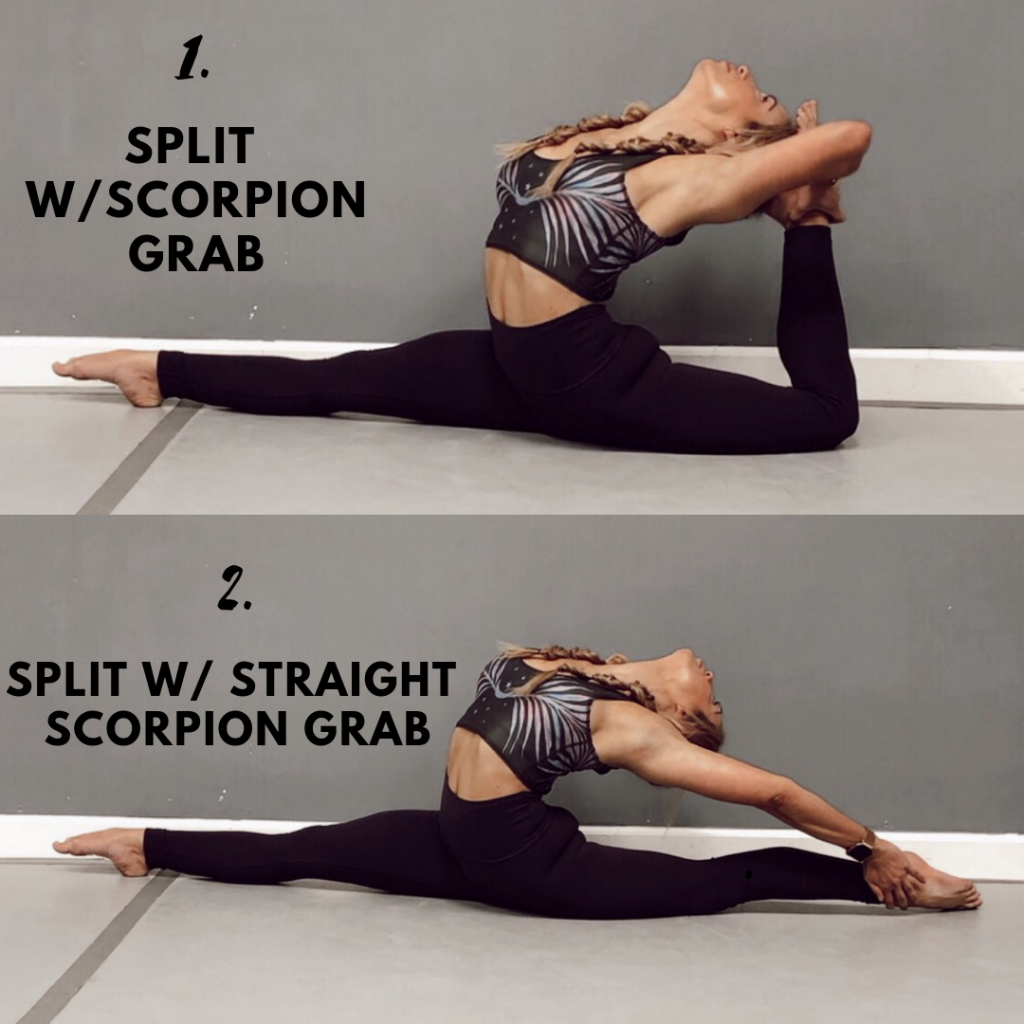
The last stretch we will go over in this post is the split with scorpion grab. Start in your front split with leg you intend to have in the air behind you. For instance, I prefer to grab my left leg in a scorpion so I am doing my R leg split with left leg behind. Then bend your knee and grab your foot with the same arm. Slowly straighten your leg while maintaining your grip. For an extra challenge, try grabbing the foot with the opposite hand and repeating.
There are many more skills and stretches you can practice to help with your scorpion but these are a great start:)
December 4, 2018/By theadance/0 Comments/0/Flexibility, Uncategorized
4 BENEFITS OF DANCE FOR KIDS!
-
Dance Promotes creativity – Becoming a skilled dancer requires practice, discipline, and focus. These skills can be very useful in other areas of your child’s life. According to “FamilyTalk Magazine,” dance lessons can help to spark creativity in young children and help them to develop an appreciation for the arts.
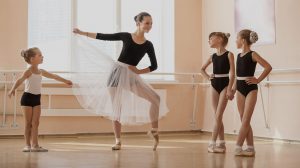
2. Improves self-esteem – As children learn the movements and postures required in dance, they begin to get a better understanding of their bodies. As they become more comfortable in their own skin, their confidence and self-esteem also improve. According to EduDance, dance lessons can encourage children to foster a more positive attitude and explore their own self-expression.
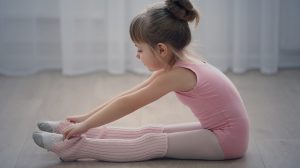
3. Improves physical health – Dancing is a highly physical activity! Kids who take dance lessons regularly can expect to see a great improvement in their overall physical health. According to Pro Dance Center, regular dance practice can increase your child’s flexibility, range of motion, physical strength and stamina. The repetitive movements involved in dance can improve muscle tone, correct poor posture, increase balance and coordination and improve overall cardiovascular health.
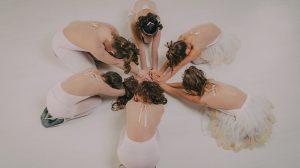
4. Educational benefits – Students who regularly participate in dance lessons typically tend to perform better academically than their nonparticipating peers. “FamilyTalk Magazine” estimates that students who have a background in dance tend to achieve significantly higher SAT scores and do better in math and science competitions.
READY TO PUT YOUR LITTLE ONE IN DANCE? REGISTER HERE !
References:
Lake, R (2017, September 7th) “What are the benefits of dance for kids” retrieved from https://www.livestrong.com/article/214791-the-benefits-of-dance-for-kids/
November 6, 2018/By theadance/0 Comments/0/Flexibility, Health and Harmony
HOW TO ACHIEVE THE PERFECT STRADDLE LEAP!
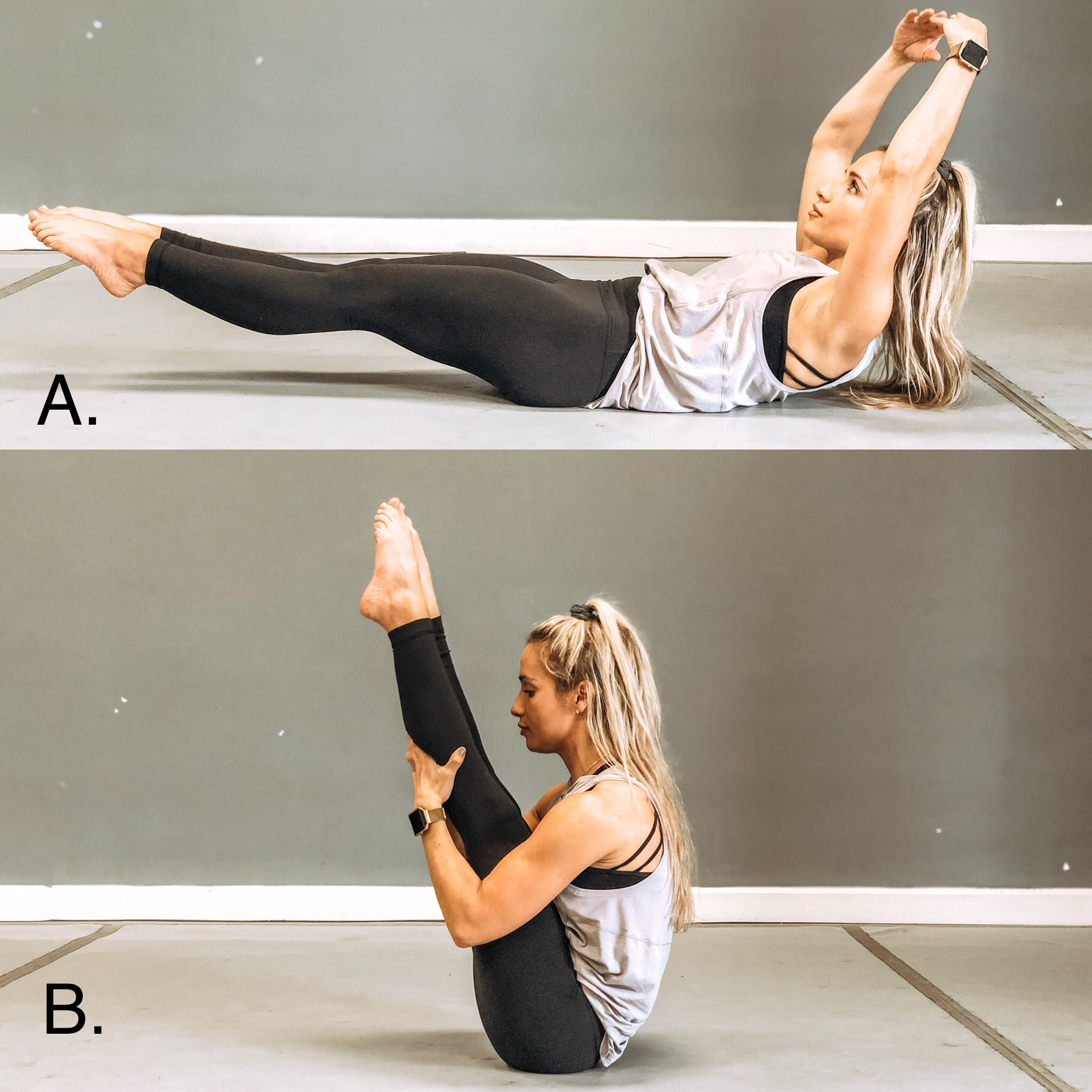
V Ups
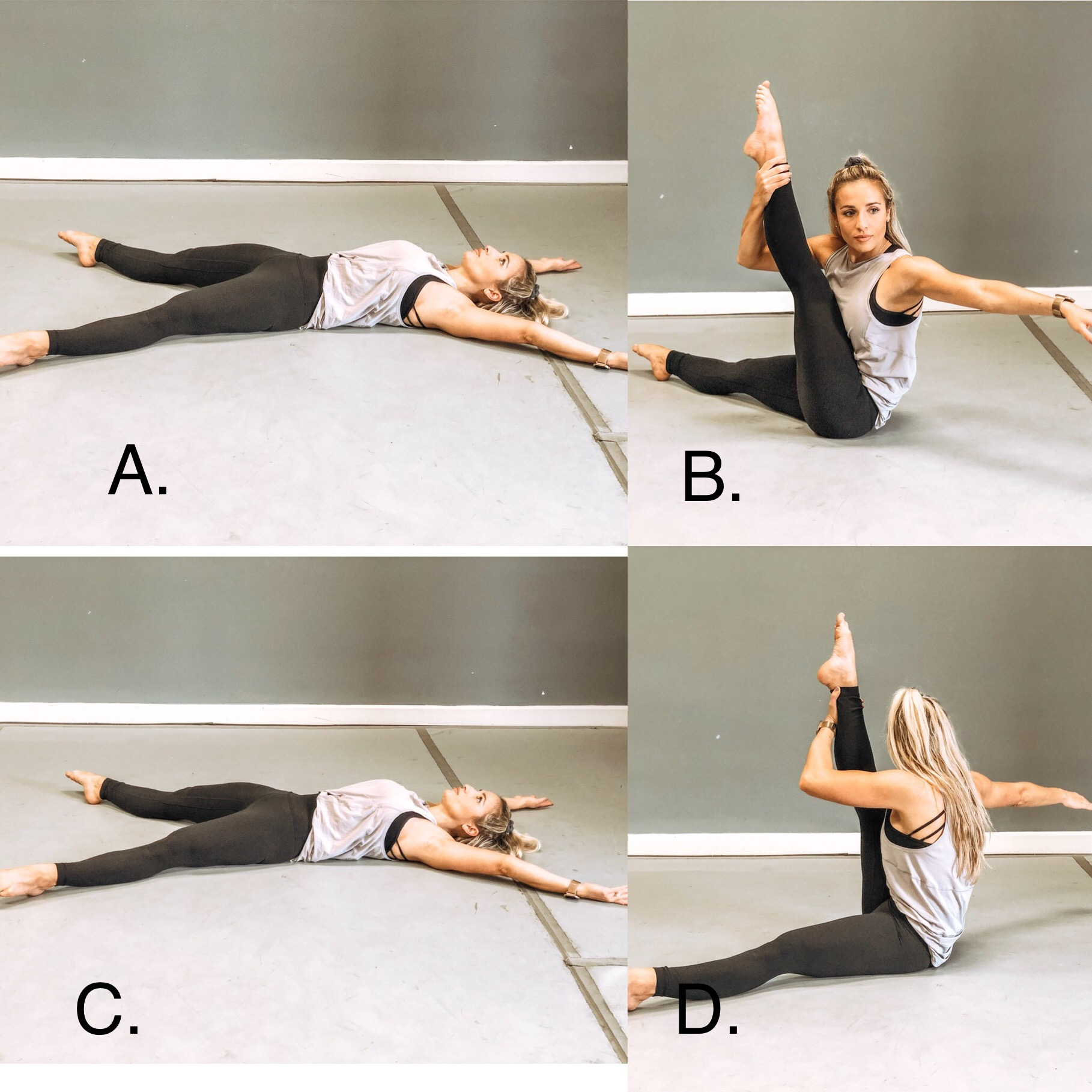
X Ups
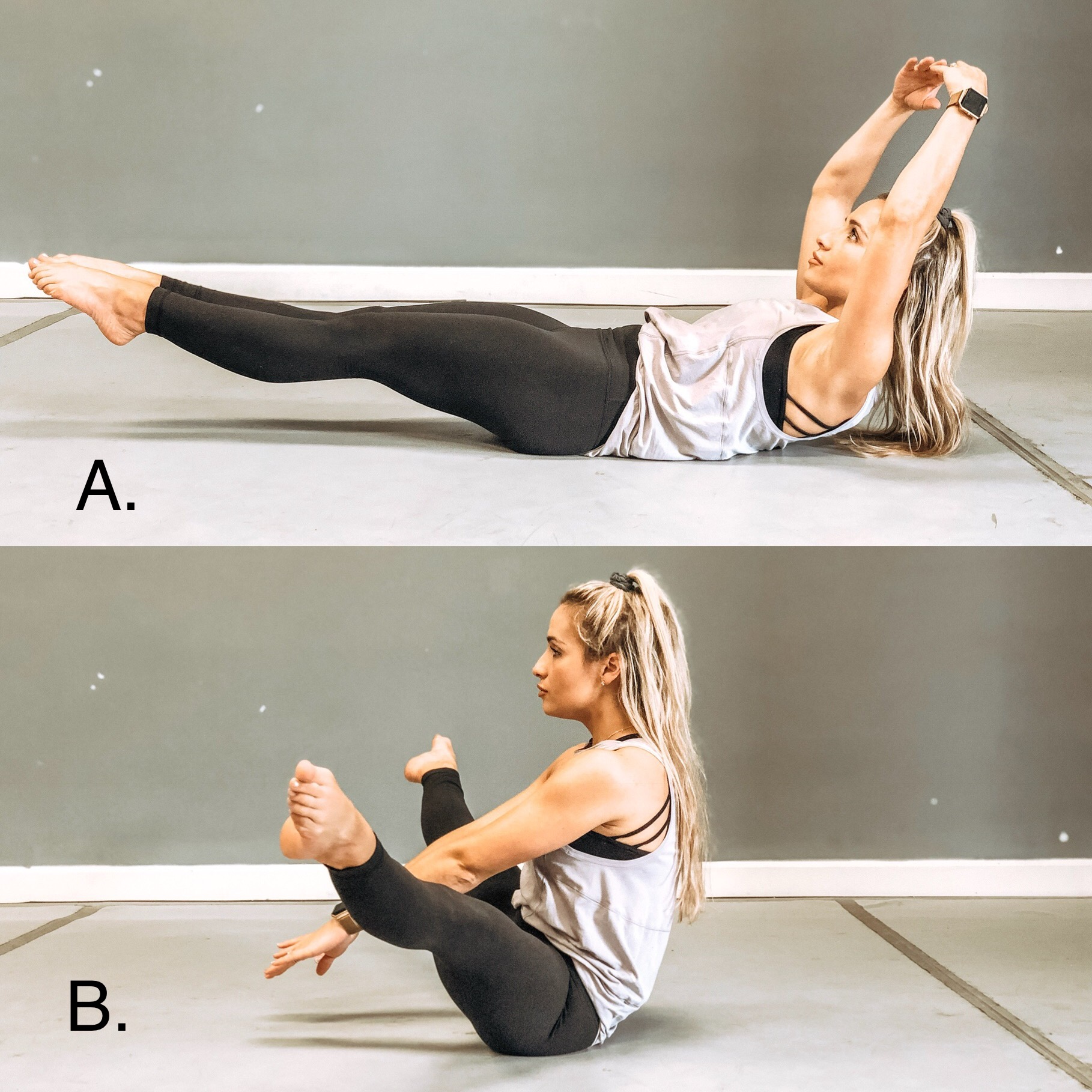
Straddle Ups
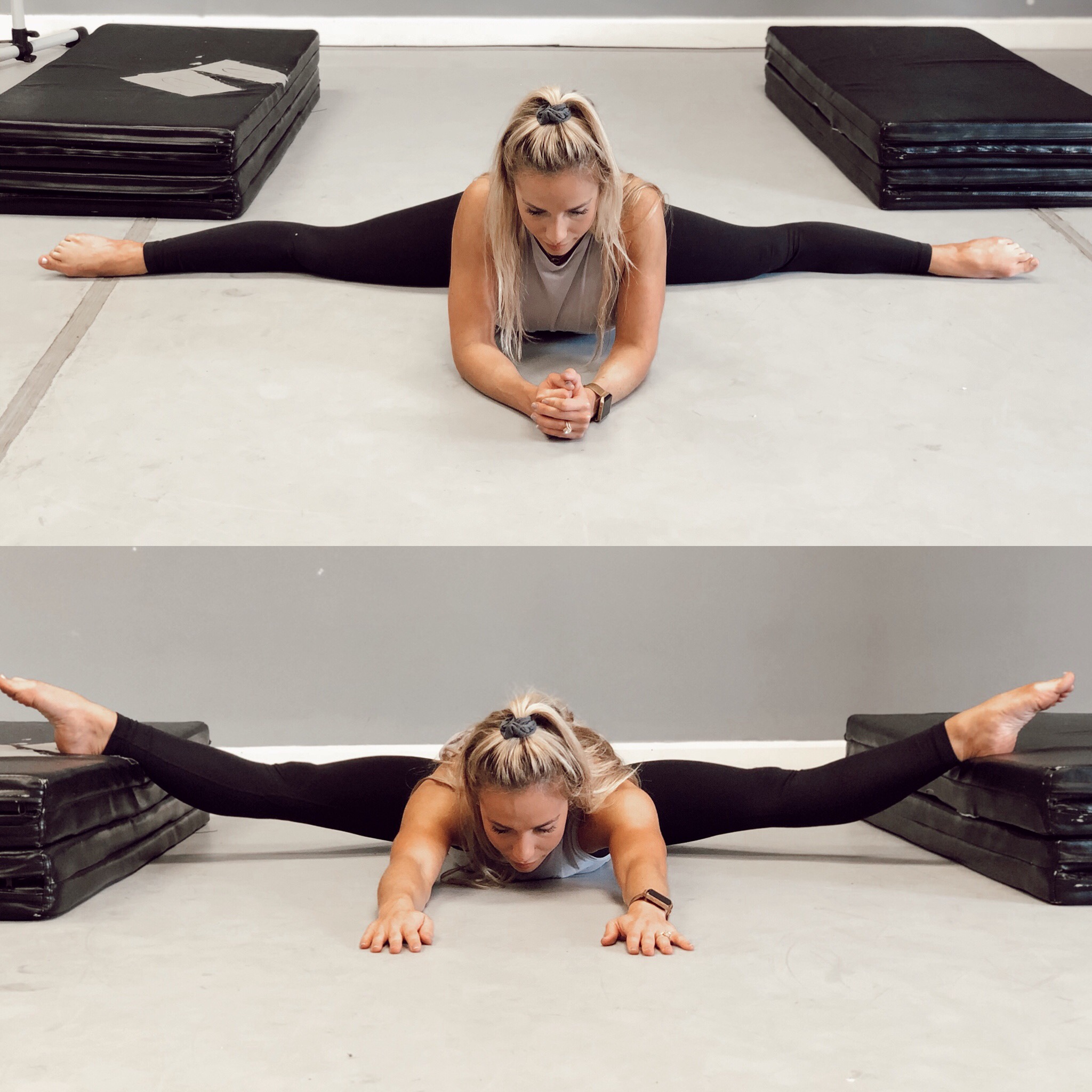
Straddle Stretch
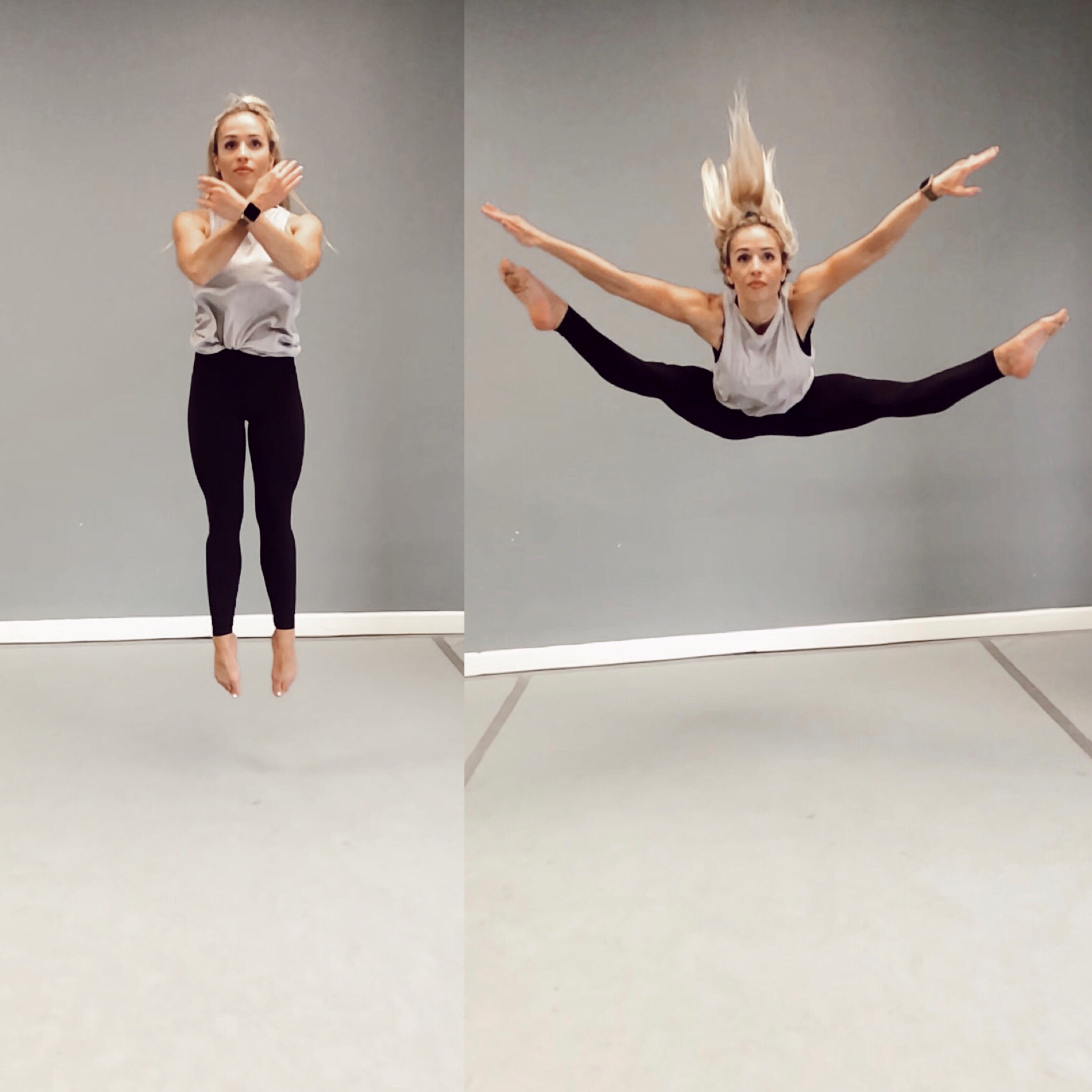
Saute to Straddle Jump
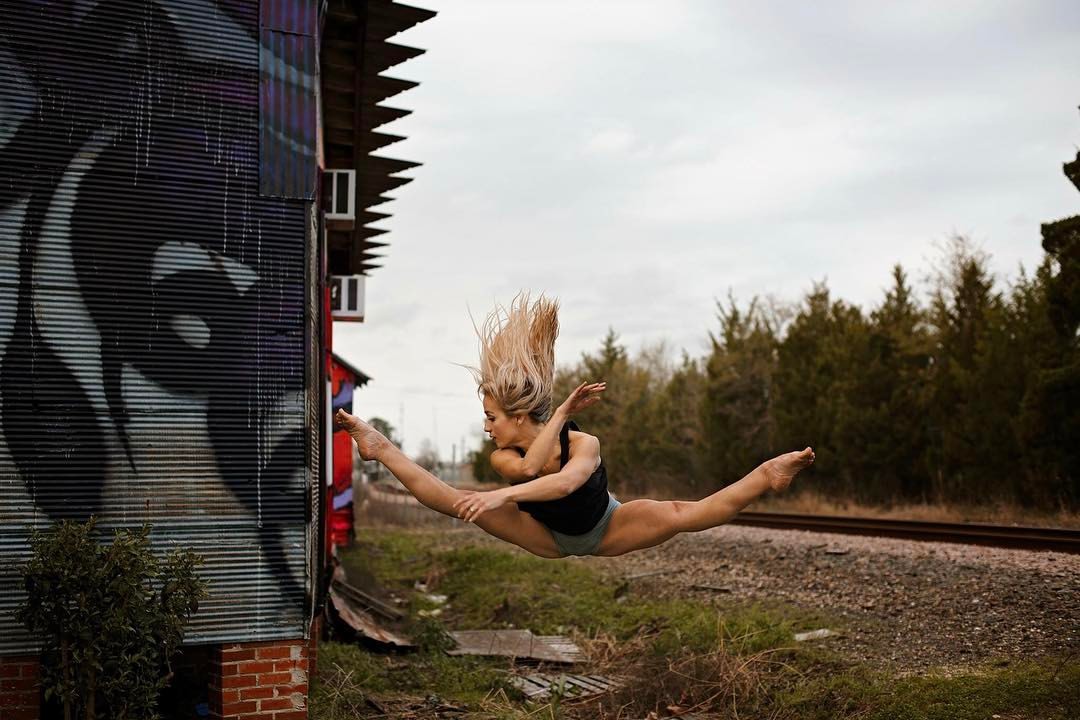
HOW TO ACHIEVE THE PERFECT STRADDLE LEAP!
I THINK WE CAN ALL AGREE THAT THERE ARE 2 IMPORTANT FACTORS WHEN IT COMES TO GETTING YOUR PERFECT STRADDLE LEAPS OR JUMPS. THESE BEING STRENGTH AND FLEXIBILITY! IN THIS POST, I WILL GO OVER 5 EXERCISES/STRETCHES THAT WILL HELP YOU TO ACHIEVE YOUR BEST STRADDLE LEAPS.
1.V UPS- Start by lying in a hollowed position on the floor(head, shoulders and lower legs off of the floor), engage the core and lift upper body and legs in a piked position until you are in position B. Slowly lower back into position A and repeat. You can also perform this exercise by bending your knees in Position B if you do not have the range of motion available for pike.
2.X UPS- Start by lying flat on the floor with arms and legs wider than shoulder-width apart. Your body should look like an X. Engage the core and reach your Right arm to your left Leg, twisting in the core and lifting the entire upper body off of the floor. Return to the X position and then repeat on the opposite side.
*For more of a challenge pull your leg closer to your body when you grab each leg:)
3.STRADDLE UPS- Start by lying in a hollowed position on the floor(head, shoulders and lower legs off of the floor), engage the core and lift upper body and legs until you are in position B, seated straddle. Slowly lower back into position A and repeat.
4.STRADDLE STRETCH- First, you will stretch out your front split by simply laying on the floor starting with your legs out in a straddle position. Then, pull your hips forward until they are in line with your ankles for a full split. Depending on your flexibility, your hips may not be all the way down to the floor. This is okay! Just go where you can. Hold this for at least a minute. Once you have done this, try using mats or another raised surface to stretch into an oversplit. You can either keep your bottom on the floor or lift yourself into full split if you have the range of motion available.
5.SAUTÉ INTO STRADDLE JUMPS- This exercise is great for building up the strength and power needed to get height in your leaps. Start by standing in 1st position and jump into the air squeezing legs tight and fulling extending the legs while bringing your arms through preparation. Once you have landed the saute jump, immediately jump again into a straddle jump. Repeat this as many times as possible without pausing. Saute, straddle, saute, straddle, etc etc… Make sure that your legs are fully extended and feet pointed in your straddle jumps. If you need to lower your jumps to maintain proper technique then do so! Remember, it is better to have a lower jump with proper technique than a higher jump with poor technique.
Keep working on these techniques and you will be amazed at the improvements in your straddle leaps!
October 25, 2018/By theadance.0 Comments.0.Flexibility
5 EXERCISES TO CORRECT YOUR DANCERS SICKLED FEET!
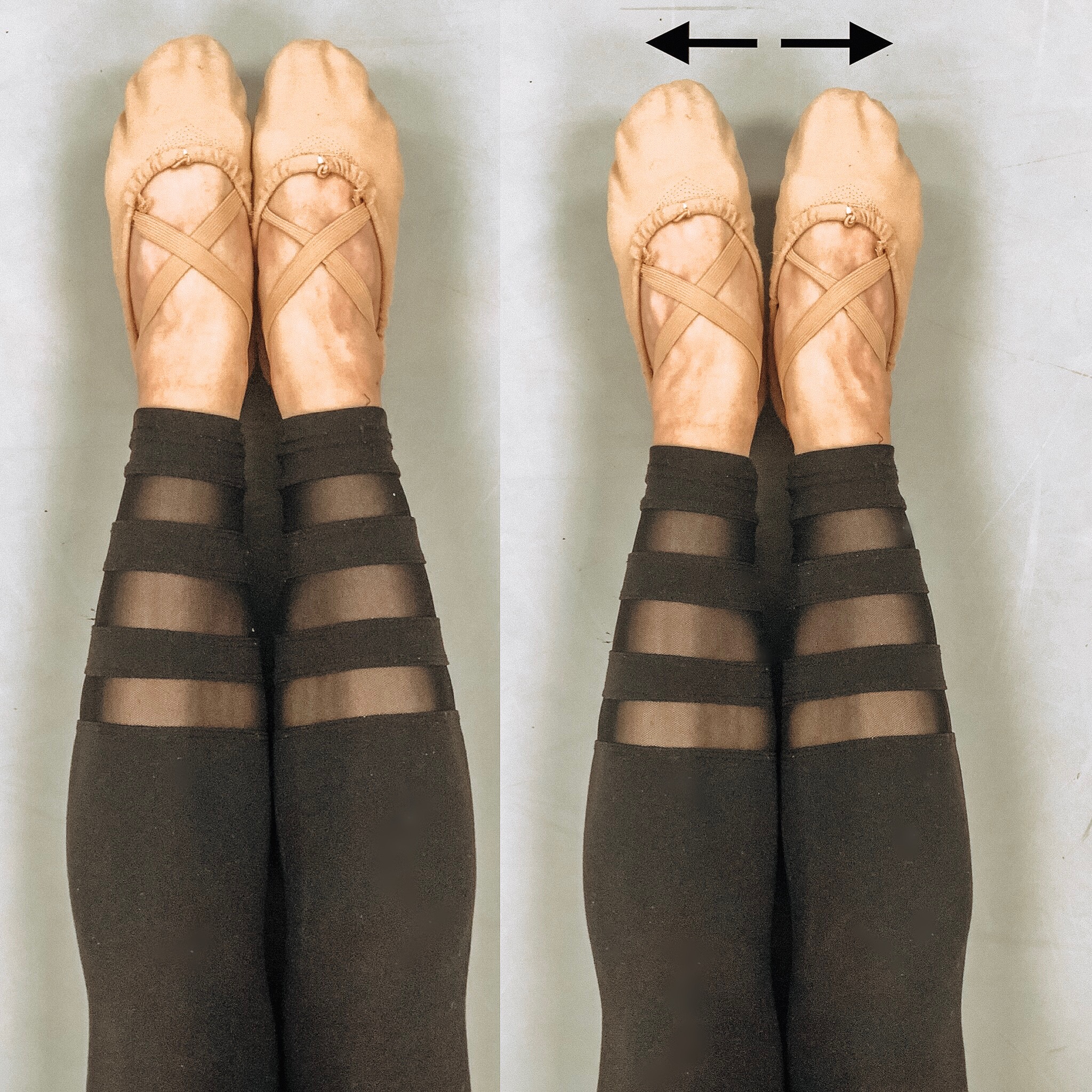
Pointed Eversion Pulses
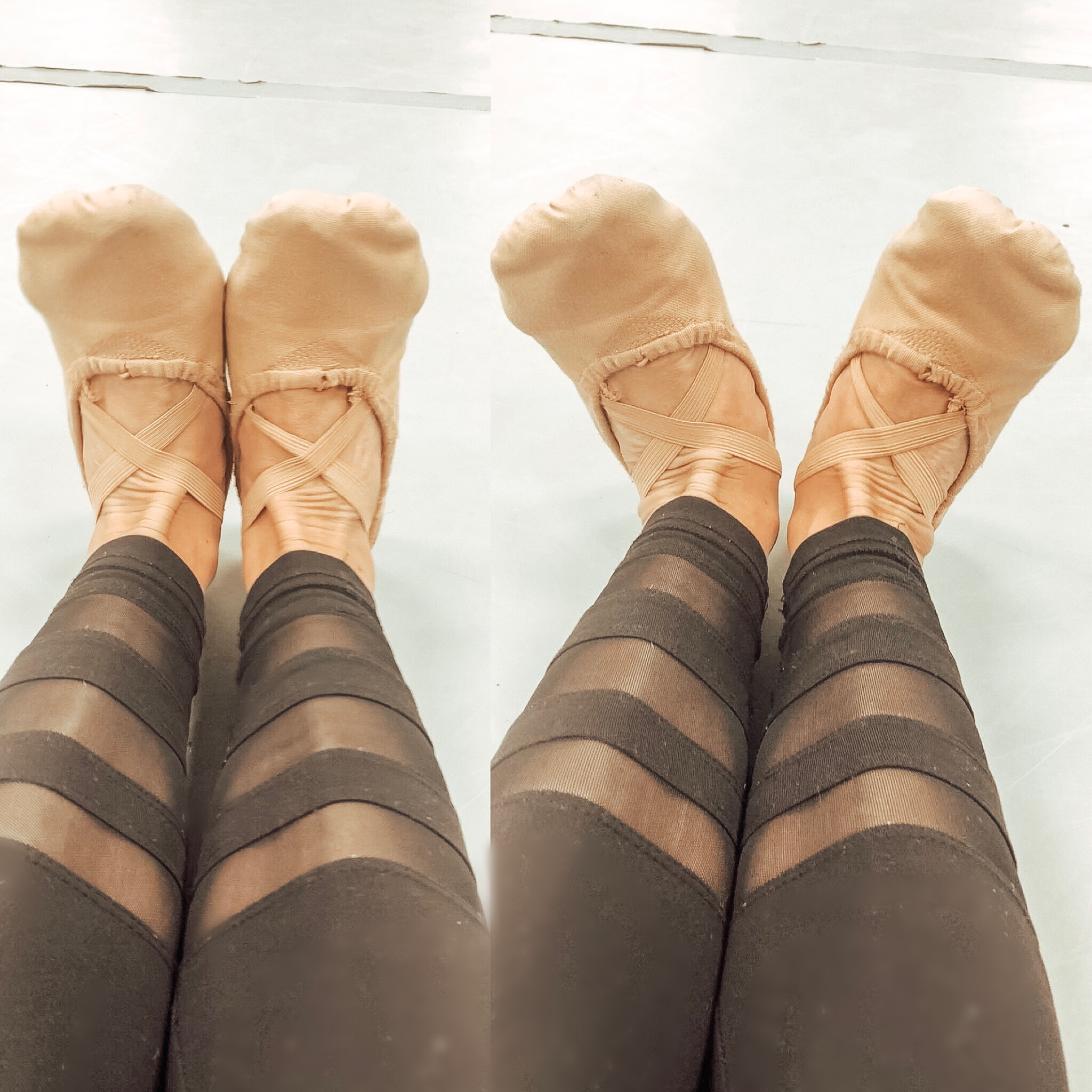
Flexed Eversion Pulses
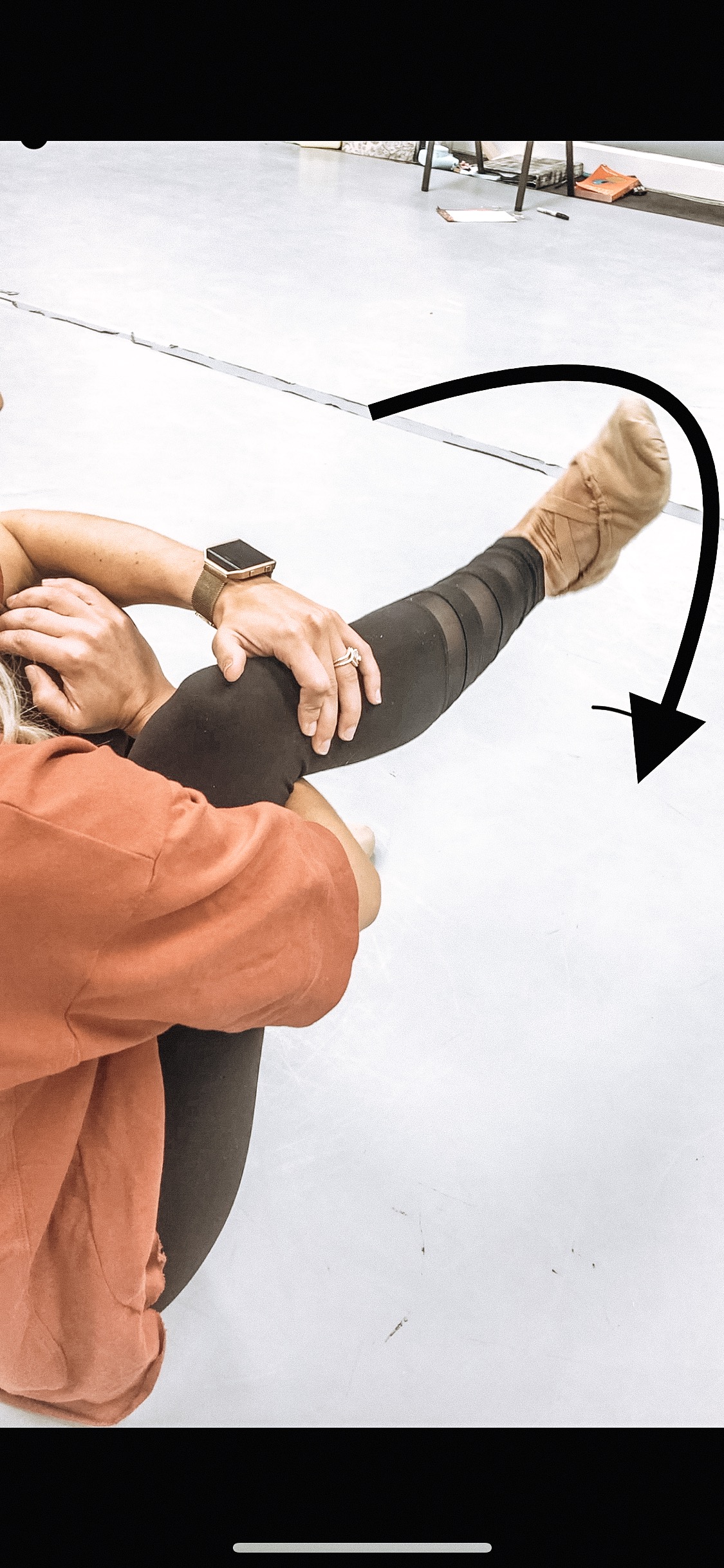
Foot Circles
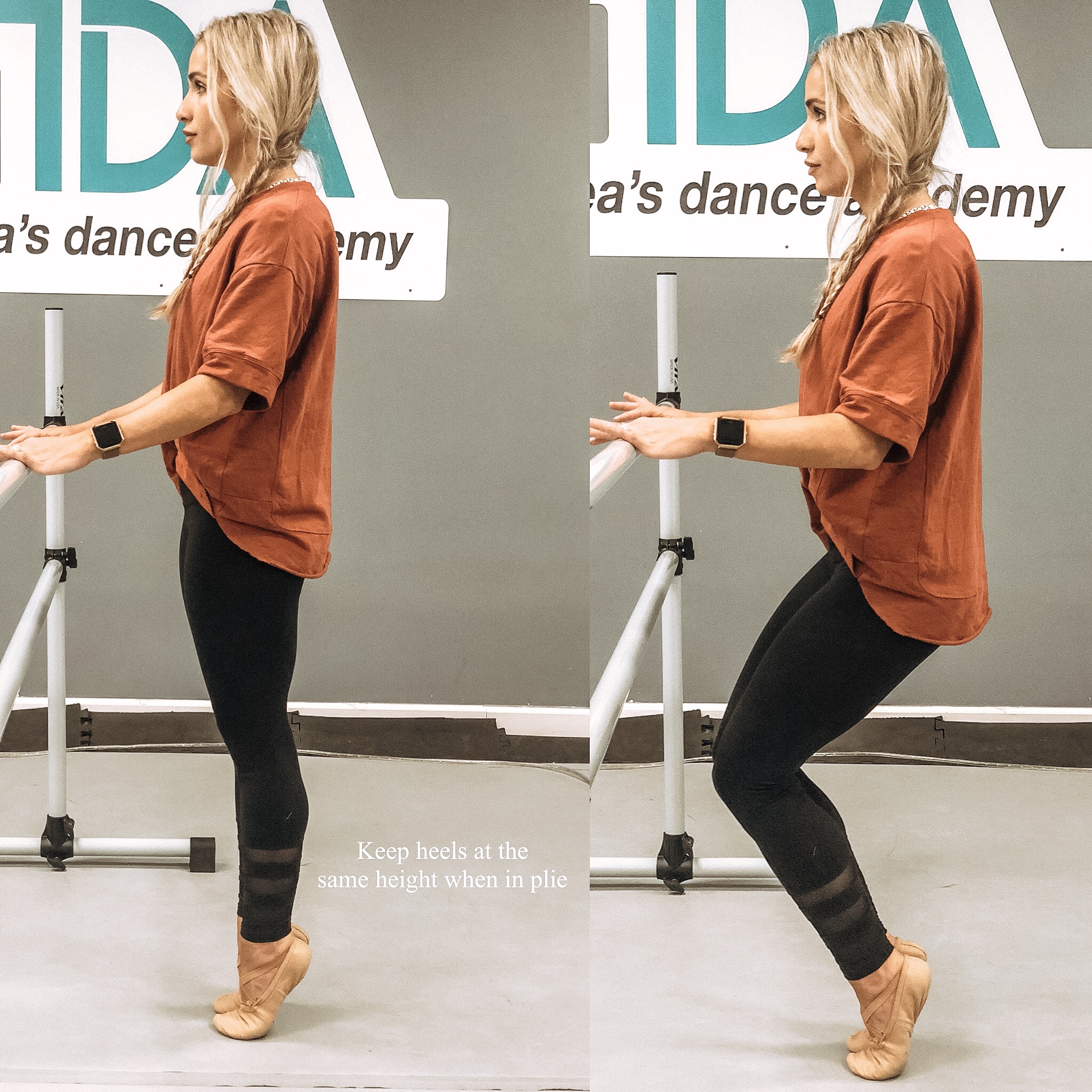
Forced Arch Plie
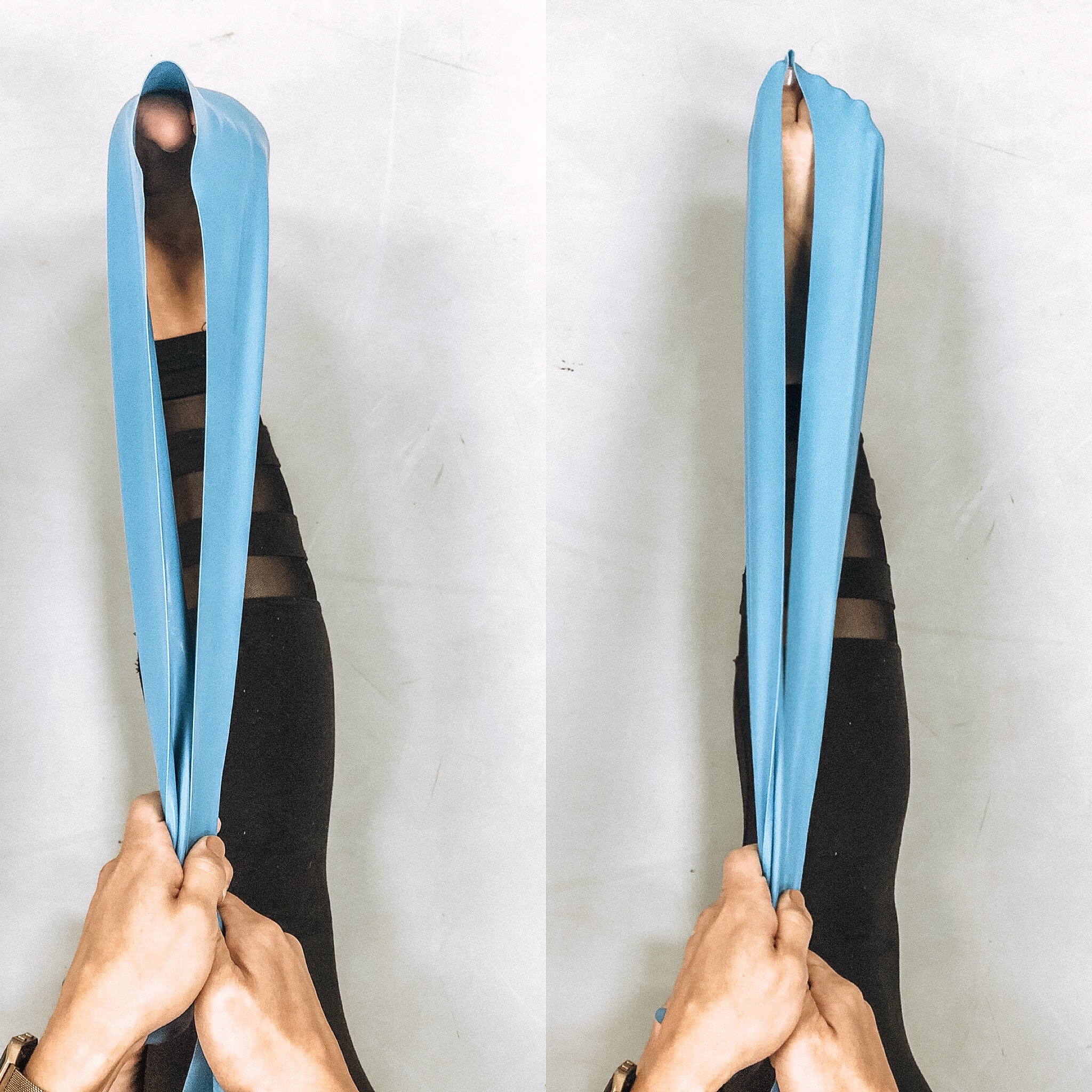
Banded Flex to Point
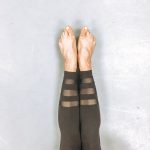
We have all seen them! The beautiful dancer who moves gracefully across the floor and then BAM! They lift their leg for an extension and our eyes can only see the terribly sickled foot. This correction is one that needs to made early on for dancers so that they can retrain their muscles to stretch through the foot properly without inversion of the foot. In order to do so, we need to train the peroneal muscles, which are responsible for concentrically plantarflexing and everting the foot.
These 5 Exercises will do just that while helping to increase the range of motion in your dancer’s ankle and foot! Which is also crucial to a nice pointed foot.
1.Parallel Pointed Eversion Pulses- Start in a seated position on the floor with the inside arches of your feet together. Without changing the rotation or placement of your legs or ankles, try to move your big toes away from each other for 4 counts and then release back together for 4 counts. Repeat this exercise 10-20 times.
2.Flexed Eversion Pulses- Remain in the seated position and flex your feet starting with heels together. Slowly evert your feet without moving your ankles. Then return to starting position and repeat 10-20 times.
3.Foot Circles- Starting in a seated position lift one leg and hold the knee so that your lower leg is parallel to the floor. Slowly make big circles with your foot in one direction. Do this 10 times and then switch directions. Repeat on other foot.
4.Forced Arch PliÈs- Starting in a parallel standing position facing a ballet bar with the inside arches of your feet together. Slowly bend into plie, allowing the knees to fall forward past the toes. Then slowly return to starting position and repeat 20 times. You should feel a good stretch in the balls of your feet.
5.Banded Flex to Point- Sitting on the floor with one leg stretched out in front of you, place an elastic band around the ball of your foot covering the big toe. As you pull on the ends of the band to add resistance, move your foot from a flexed position to a pointed position back and forth 20x. Make sure you are not sickling when you are pointing through this exercise.
Do these exercises before class for a great ankle and foot warmup or at home for extra practice. You will be amazed by how well they work! Thanks for reading and be sure to share with a friend!
August 30, 2018/By theadance/0 Comments/0/Flexibility, Health and Harmony
THE IMPORTANCE OF SELF MYOFASCIAL RELEASE OR “FOAM ROLLING”
If you are looking for ways to increase your flexibility and joint range of motion you should definitely try the foam rolling technique. As a dancer we often use static stretching(30-60s holds in the desired position), active stretching(activating one muscle to allow the other to relax and holding for 1-2s then repeating) and dynamic stretching(taking joints through full range of motion at a steady pace), but I have never seen a dancer use SMR.
I believe this is probably because of the lack of knowledge and know-how in this practice. As of recently, I have started to incorporate SMR with my own stretch routines as well as with my students who either have muscles imbalances or have a hard time with muscle extensibility. I have been amazed at the results and how quickly positive adaptations have been made. With that being said, let’s dig into how exactly SMR is used and why. SMR is a proven inhibition technique that increases the range of motion and muscle flexibility as well as improving muscle imbalances and altered joint mechanics.
One of the most common misconceptions when it comes to foam rolling is that you should “roll fast to get your muscles ready for activity.” Using SMR as an activation technique is not supported by scientific evidence and therefore is not suggested. Instead, you should roll desired muscle slowly until you find a spot of tension. Once the tender spot is found simply hold with no movement for 20-30 seconds before finding one or two more spots and repeating. You may feel the need to tighten the muscles surrounding the muscle being rolled, instead try to relax and allow the foam roller to work its magic. The timed hold is important because of the principal of autogenic inhibition.
Each of our skeletal muscles has two important mechanoreceptors involved with flexibility, muscle spindles and Golgi Tendon organs(GTO). When your muscle length changes as in stretching, the muscle spindles are stimulated causing the muscle to contract to protect them from stretching too far. When this contraction happens it creates tension and as the stretch is held more tension is created. This change in tension stimulates the GTO and causes the muscle to relax and elongate. This process is known as Autogenic Inhibition. If the stretch or tension is not held long enough to produce ample amounts of tension that will then stimulate the GTO, the muscle will remain in a contracted state until you are no longer in stretching position. Therefore not allowing joints to move into a greater range of motion with increased muscle length. This process can lead to permanent adaptations in the muscles and associated tissues if SMR is used correctly over time.
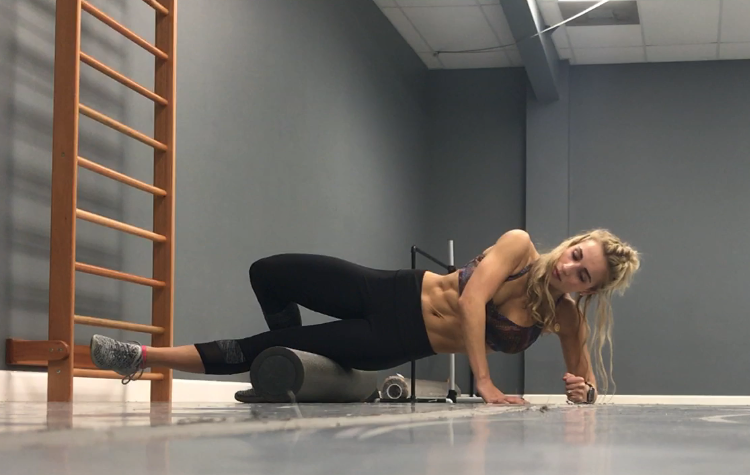
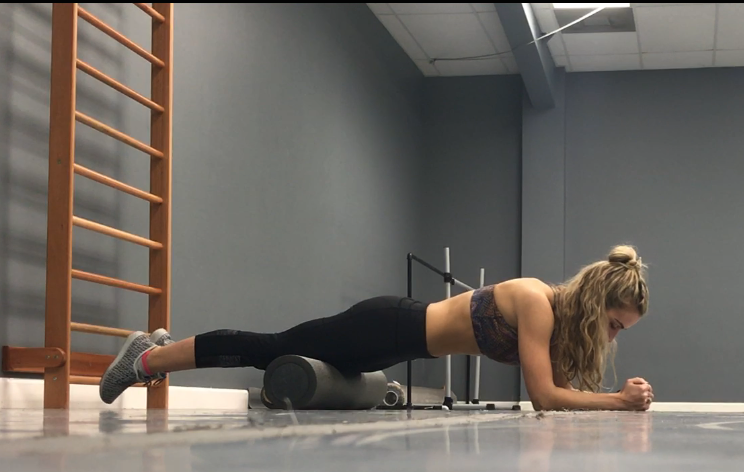
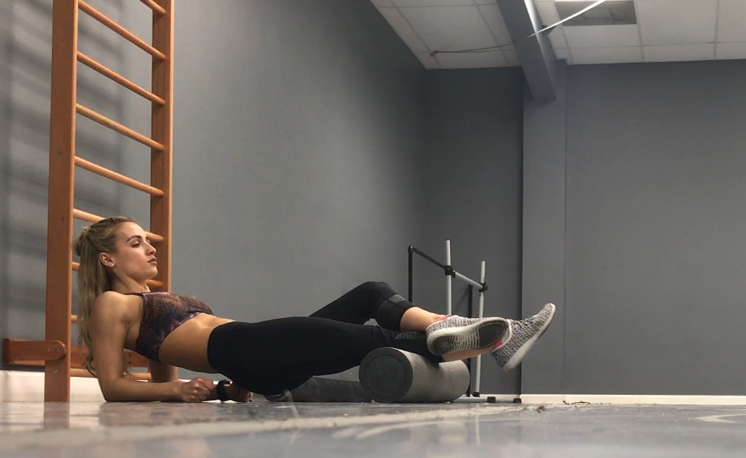
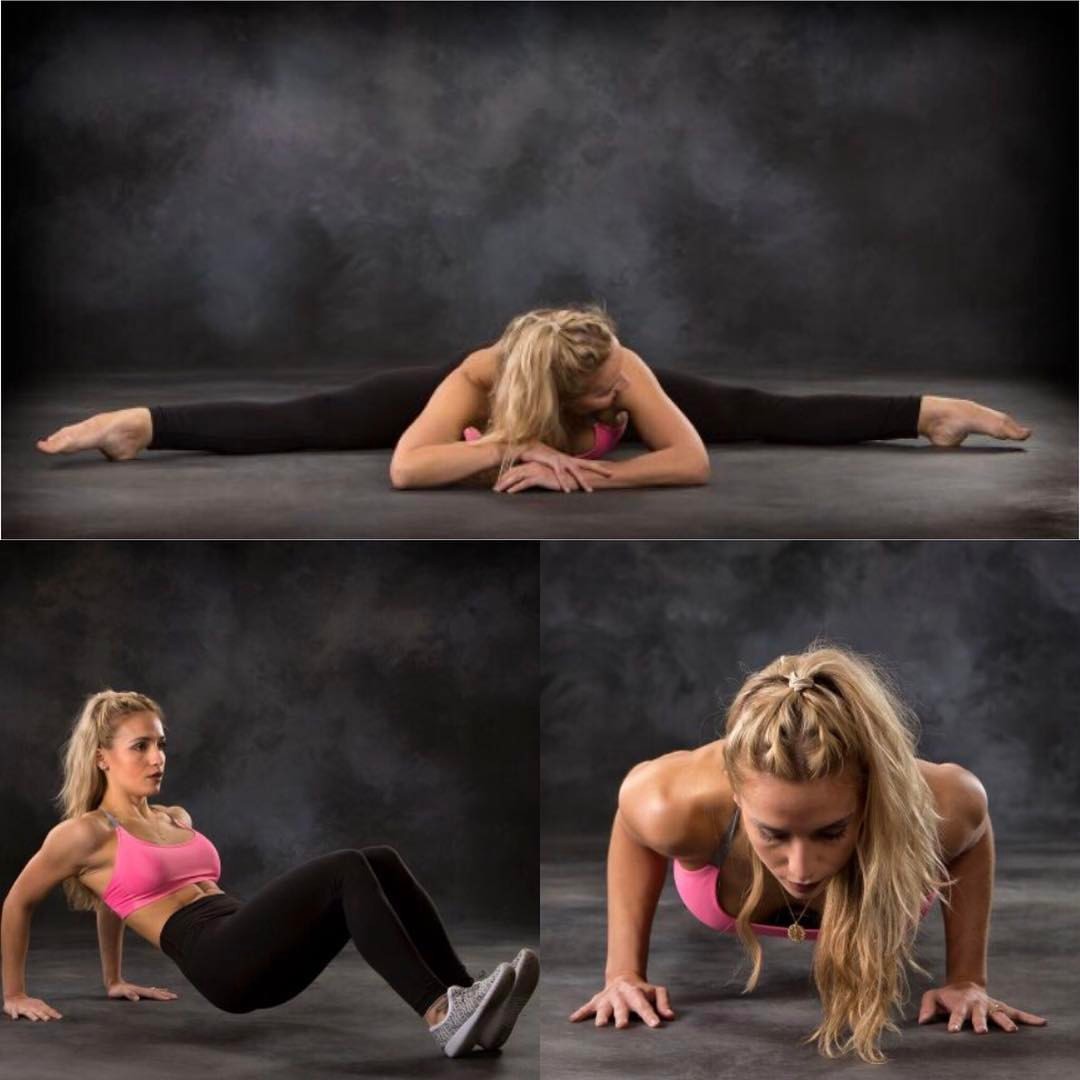
August 30, 2018/By theadance/0 Comments/0/Flexibility, Health and Harmony
CORRECTING MUSCLE IMBALANCE!
Why is stretching and strengthening the appropriate muscles important!? Why are these actions helpful?
The answer is because of muscle imbalances. In order for our body to function with human movement efficiently, we require a balance of muscle length and muscle strength around a joint. If these muscles are not balanced, then the associated joint is directly affected. Which in many cases is the cause of pain, such as lower back pain or knee pain.
For example, a muscle imbalance at the knee involving a “tight” biceps femoris will cause the knee to move inward(knee valgus) during an exercise such as a squat. This is due to the instability around this joint caused by muscle imbalances. Consequently, Knee Valgus can lead to a variety of knee issues if not addressed. When dealing with movement compensations such as Knee Valgus, there are always going to be multiple muscles involved. Thus the importance of using stretch and strengthening exercises simultaneously.
However, the most important aspect is to be sure you are targeting the appropriate muscles. For example, the biceps femoris is likely the “tight” and “overactive” muscle when it comes to knee valgus, but the VMO(vastus medialis oblique) is “lengthened” or “underactive.” In this scenario, we would work on lengthening the overactive biceps femoris by using flexibility exercises while shortening the underactive VMO with strength exercises.
Knowing which muscles to stretch and which ones to strengthen can be quite confusing, this is why it is very important to get with a certified professional to get on a corrective exercise program to avoid future injuries.
With that being said, I hope this post helps you to understand the importance of utilizing both stretch and strength exercises. We hope to see you in our Stretch/Strength classes on Tuesday evenings! For more info on classes visit: theasdanceacademy.com under the adult class tab! As always, don’t forget to subscribe to our future blog post!
August 30, 2018/By theadance/0 Comments/0/Flexibility, Health and Harmony
1 MONTH TO SPLITS!
If you are reading this, it is probably because you’d like to gain flexibility and be able to perform a front split with ease! There is no doubt that most of us do not enjoy stretching and even if we do, keeping track of our efforts is seemingly impossible. With this in mind, I have created a 1 month to front splits log so that you can keep track of your stretching and keep yourself accountable! If you would prefer to not use a log and just want to follow these stretches for fun that is fine too;)
Now let’s talk about a few guidelines for the stretches below
-
1. Be sure your muscles are warm before starting. After a hot bath or after dance class is a great time to stretch.
-
2. You may use a block for any of these stretches to assist.
-
3. Hold each stretch for 1 minute before repeating on the other side.
-
4. This should not be painful. Discomfort is normal but actual pain is a sign you are pushing too far
-
Allow your muscles to ease into the position desired.
-
5. Be sure to take pictures of your splits on Day 1 so that you can track your progress! Looking for the log?? Simply email me @ [email protected] and I will send you the attachment
